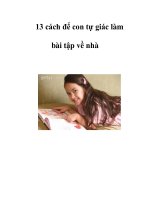CÁCH NHẬN BIẾT từ LOẠI dựa vào cấu tạo từ KHI làm bài tập
Bạn đang xem bản rút gọn của tài liệu. Xem và tải ngay bản đầy đủ của tài liệu tại đây (22.33 KB, 1 trang )
CÁCH NHẬN BIẾT TỪ LOẠI DỰA VÀO CẤU TẠO TỪ KHI LÀM BÀI TẬP
I. Danh từ (nouns): danh từ thường kết thúc bằng: -tion/-ation, -ment, -er, -or, -ant, -ing, -age, -ship, -ism,
-ity, -ness
Ex: distribution, information, development, teacher, actor, accountant, teaching, studying, teenage,
friendship, relationship, shoolarship, socialism, ability, sadness, happiness
II. Tính từ (adjective): Tính từ thường kết thúc bằng: -ful, -less, -ly, -al, -ble, -ive, -ous, -ish, -y, -like, -ic, -ed,
-ing
Ex: helful, beautiful, useful, homeless, childless, friendly, yearly, daily, national, international, acceptable,
impossible, active, passive, attractive, famous, serious, dangerous, childish, selfish, foolish, rainy, cloudy,
snowy, sandy, foggy, healthy, sympathy, childlike, specific, scientific, interested, bored, tired, interesting,
boring
III. Trạng từ (adverbs): Trạng từ thường được thành lập bằng cách thêm đuôi “ly” vào tính từ
Ex: beautifully, usefully, carefully, strongly, badly
Lưu ý: Một số trạng từ đặc biệt cần ghi nhớ
Adj - Adv
good -well
late - late/lately
ill - ill
fast - fast









